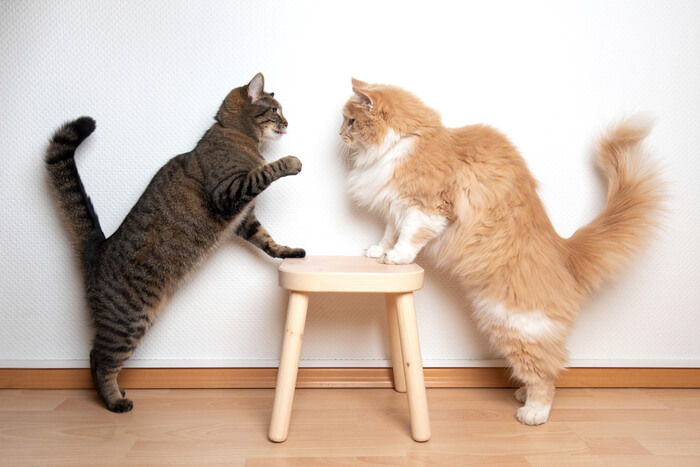
Are you trying to figure out if your cats are playing or fighting during wrestling matches? Cat behavior can be hard to interpret, particularly when there is a mix of ages, breeds, temperaments, and unrelated cats living in one household.
This article will help you distinguish between a play date and a catfight, and how to encourage harmonious living in multi-cat households.
When cats are play fighting, they are enjoying themselves, forming social bonds with their peers, and learning how to hone their natural hunting instincts. Cats can become overstimulated during play fights, which can then turn into real fighting. There are distinct differences between how play fighting and real fighting between cats appear, and these differences are important for cat owners to know.Key Takeaways
The Social Affiliation of Cats
There is a substantial body of evidence that, although domestic cats are solitary animals and capable of living alone, they also form social bonds. Whether in high-density colonies or in groups of related individuals, cats maintain coherence by creating a group odor via allogrooming/allorubbing.
Moreover, affiliated cats are less likely to exhibit overt aggression toward each other as long as there are sufficient environmental resources.
Likewise, cats socialized together during their formative kitten years may develop affiliative relationships with each other, which will be maintained into adulthood. Such cats, therefore, form a more harmonious multi-feline household.
It is imperative to note that social relationships between cats can shift throughout life.
How To Tell if Your Cats Are Playing or Fighting?
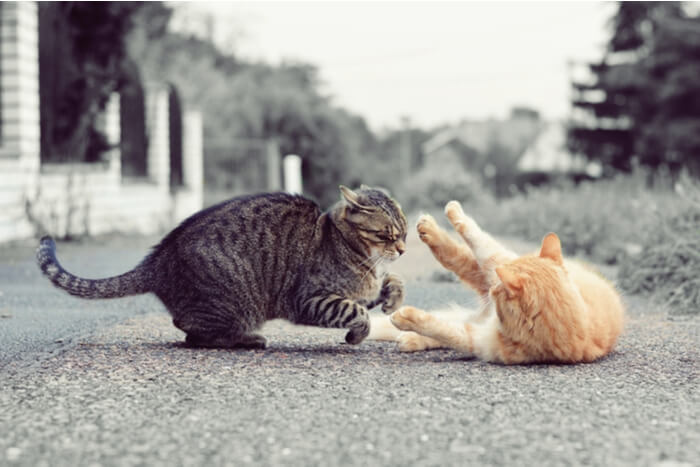
Most cats in affiliated social groups will engage in play fighting.
Play is important for all cats. Whether young or old, play has a positive impact on a cat’s emotional state while providing stimulation from boredom and helping to develop and maintain social bonds. Unlike dogs, who use play as a form of social interaction, the motivation for play in both kittens and adult cats is centered around predatory behavior. Play fighting among cats is normal and healthy behavior.
How Do Cats Play With Each Other?
Sibling cats commonly indulge in play sessions that include stalking, chasing, as well as pouncing. At times, these play sessions seem like fights. Some play sessions can lead to an individual cat becoming over-stimulated and boisterous, which can be stressful for a cat that is not as excitable. Keep a close eye on these situations when they arise, and diffuse tension to avoid escalation when one or both cats display signs of aggression.
Cats are prone to indulge in social play in the right type of environment. A play space could be full of fun obstacles, hiding holes, cat trees, activity centers, and boxes with entry/exit holes to name a few examples.
Cats communicate through body language and to a lesser extent through vocalization. The overall social relationship between cats should be considered when determining if they are displaying playing or fighting behavior since these expressions can also be individual.
Signs Your Cats Are Playing
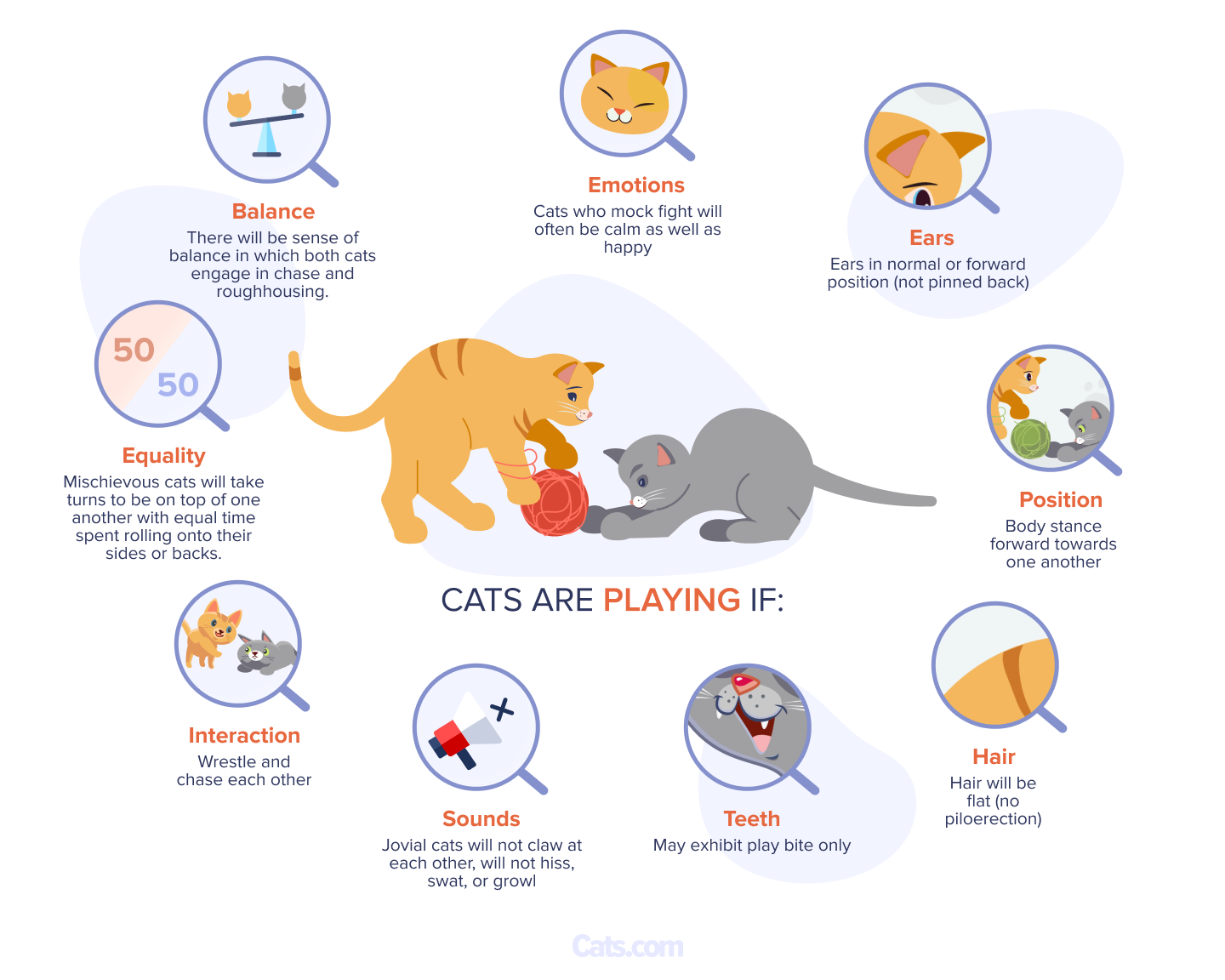
Kittens are very social and have a high play drive from an early age. They are taught skills such as grooming, feeding, and hunting by the queen and rely on collaborations with littermates to learn social skills.
Inter-cat social play peaks around 8-10 weeks of age, then object play becomes prevalent. Toys present an outlet for natural predatory sequences as part of play, which prevents play biting.
Cats can be playful into old age; however, cat interactions and social play may decline with maturity.
The following are indicators that your cats are playing:
- They remain calm and happy during the interaction.
- The ears are in a normal or forward position (not pinned back).
- The body stance is forward, facing one another.
- The fur is flat (no puffed-up tail or piloerection).
- They play bite only.
- They wrestle and chase each other.
- Jovial cats will not claw, hiss, swat, or growl at each other.
- There will be a sense of balance in which both cats engage in chasing and roughhousing.
In certain social groups, male cats can often engage in extra play fights in comparison to females, who are generally less interested in rowdiness after social maturity (around three years of age).
Signs Your Cats Are Fighting
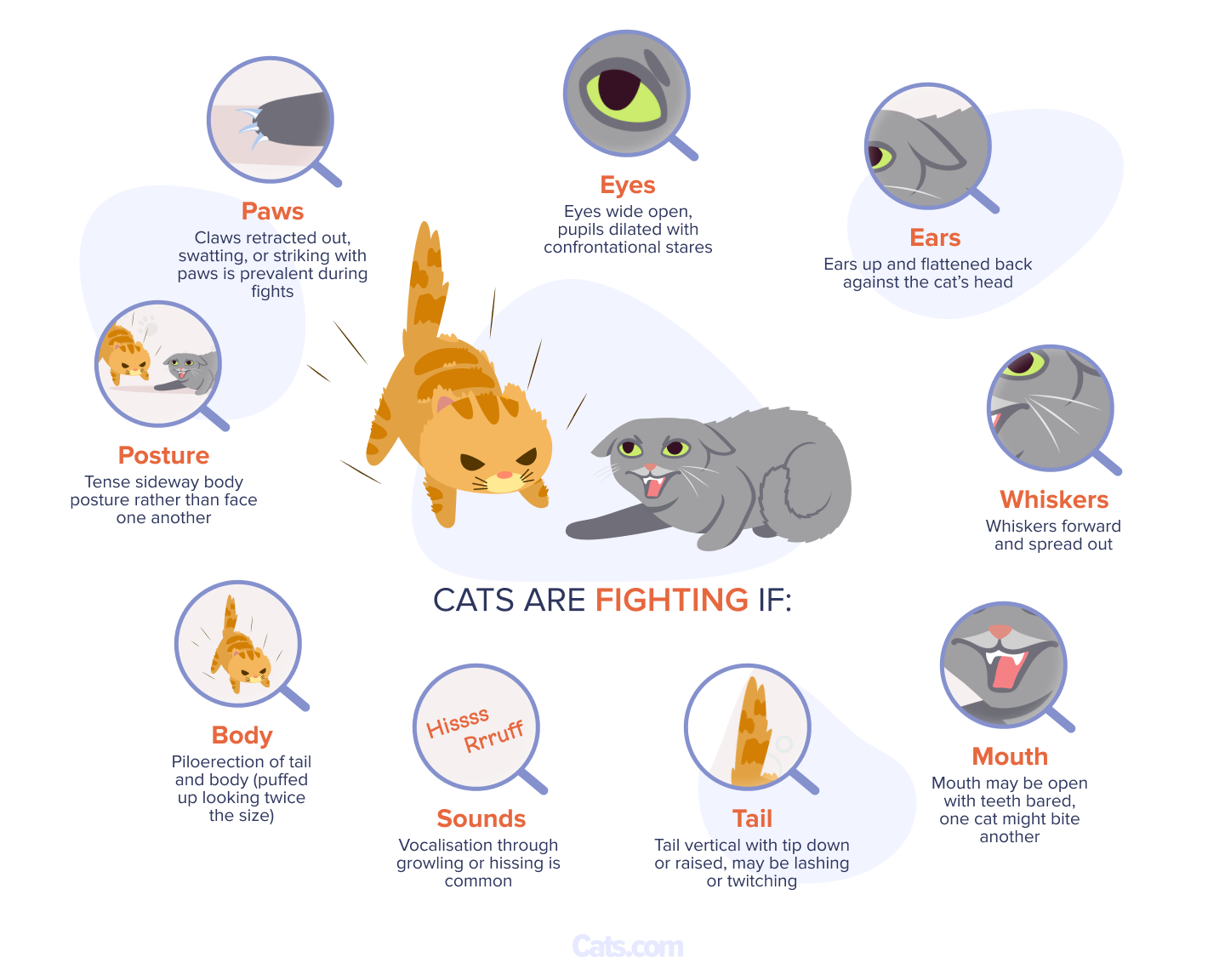
As a resourceful species, cats generally avoid physical disputes. Overt fighting can cause injury, incapacity of hunting, and even death.
Active aggression (fighting) will occur if the cat feels threatened, and avoidance prospects or escape are limited or absent.
Certain cats resort to fighting for a variety of reasons. Most cats will defend their territory (within the home or beyond) against invaders. Some cats turn to active aggression faster than others, dependent on individual genetics, sex, and early life experiences.
The following are signs that your cats are fighting:
- Their eyes are wide open and their pupils are dilated with confrontational stares.
- The ears are up and flattened back against the cat’s head.
- The whiskers are forward and spread out.
- The mouth is open with teeth bared.
- There is vocalization through growling or hissing.
- Piloerection of tail and body (puffed up, looking twice the size)
- Tense, sideways body posture rather than facing one another.
- The claws are out during swatting or striking.
- The tail is vertical with the tip down or raised, or it is lashing back and forth or twitching.
Cats cannot diffuse an aggressive situation due to limited social communication skills, so it is up to cat owners to help resolve it. It can take a couple of hours once aggression intensifies for a cat to calm down. Once separated, leave the cats alone, each in a quiet room, until they have fully relaxed.
Reasons Cat Fight
So, why do some cats fight more than others? Each cat is different, but there is a long list of factors that contribute to aggression in cats. Every situation requires a thoughtful approach to resolve while considering the individual cat’s unique circumstances. Here are the common reasons some cats fight more than others.
1. A Lack of Early-Life Socialization
The socialization period (2 – 9 weeks) is crucial for kittens. Hand-raised kittens that have not been socialized with other cats during this critical period are anecdotally at risk of developing problem behaviors such as nervousness, aggression, and reduced coping mechanisms during environmental changes.
2. New Household Members
In a 2017 study conducted with 2,492 owners of multiple cats, 73.3% noted aggression signs during the initial introduction phase of another cat. The addition of a new cat to the home correlated with the frequency of disputes and more cats in one household added recurrent tension signs.
3. Food and Resource Scarcity
Food aggression causes strife when cats from different social groups are fed in proximity and when food is scarce. Competition for resources or human attention also causes inter-cat friction.
4. Territorial Disputes
We often hear free-roaming felines fight due to a territorial disagreement, particularly at night. Cats place significant reliance on securing their territory, more so than on connections to people or other cats. Many problematic cat behaviors come from perceived threats to this security, often due to disputes with other felines.
5. Illness
Inter-cat conflict due to illness commonly presents as sudden attacks without previous disagreement between involved cats. If this occurs at your home, take your cat to the veterinarian to make sure they are healthy and thriving.
6. Protecting Kittens
Households with breeding females may also encounter episodes of aggression, especially when queens are safeguarding their kittens.
7. Genetics
Problematic cat behavior is also affected by several genes. One of them is the oxytocin receptor, which has been identified as contributing to irritability signifying that genetic testing may become an important tool in the veterinary behaviorist field.
What To Do if Your Cats Are Fighting
Inter-cat conflicts cause a lot of stress to both the resident cat(s) and their owner. When a fight occurs, do NOT place your hand or any body parts between fighting cats. Doing so can cause a major injury requiring urgent medical attention, because cat bite wounds tend to be deep, and cats harbor bacteria and other pathogens in their mouths.
The use of noise deterrents, spray bottles, and water guns are common ways that cat owners break up catfights. This, however, may be frightening for your cats and can have negative effects on an anxious cat. Never punish or touch a cat during these times, as it may cause the cat to become fearful of people.
Instead, throw a towel or small blanket on both cats to break up the fight. The goal is to distract and divert the cats’ attention.
Barrier separation, such as baby gates, cardboard, wood, or plastic boards are also useful tools to block the view of each cat.
When tensions have cooled, encourage contact through positive reinforcement. This can be achieved through separation, confinement, and gradual reintroductions.
How To Reduce Stress and Minimize Fights
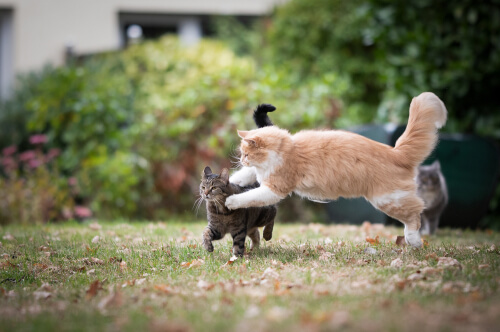
Neutering or spaying your cats will help address certain aggressive behaviors, particularly in intact males.
The best way to minimize fighting in a multi-cat household is to provide plenty of resources and enrichment opportunities to meet the needs of each cat. Environmental enrichment and multiple resources distributed around the house, such as litter boxes, beds, scratching posts, bowls, hiding spots, and perches will help to reduce stress and increase your cats’ ability to cope with disruptions.
Also Read: The 8 Best Cat Trees of 2024
Toys, puzzle feeders, foraging opportunities, and supervised outside time should be provided to all cats even if they have outdoor access. Extra enrichment should be offered to indoor cats, who can become bored and unhappy without the opportunity to indulge in hunting and exploration instincts that come with an outside environment.
Interactive personal play with each cat should be tailored to suit the individual cat. Play mimics predatory behavior for cats, so it helps to minimize play aggression.
Feliway may also help reduce inter-cat tension and habituation to a new home when used in combination with other anxiolytic products.
Neutering or spaying your cats will help address certain aggressive behaviors, particularly in intact males.
And finally, reinforcing friendly, playful interactions and taking steps to reduce aggressive behavior is reliant on the correct integration of a new cat and being aware of cat groups’ social dynamics in multi-cat homes.
If you are still unsure if your cats are playing or fighting, record their interaction and post it in the comments below, or show the video to your veterinarian or cat behaviorist.
Also Read: The 10 Best Cat Slow Feeders & Puzzle Feeders
Frequently Asked Questions
Should I allow my cats to
As long as your cats are playfully pouncing, chasing, and otherwise not showing any signs of aggression or distress, then it's a good thing to let play fighting continue. However, sometimes play fighting can quickly turn if one or more of the cats becomes overstimulated. This can lead to real fighting. In this case, separate the cats and allow them to cool off individually somewhere quiet and calming.
Do cats like each other if they are play fighting?
Most cats, especially kittens, enjoy wrestling and play fighting, as it is a natural expression of their hunting instincts. Kittens and cats that grow up together are more likely to develop a friendly relationship with each other. Sometimes these relationships persist into adulthood, although this is dependent on the individual cat.
Is it normal for cats to hiss at each other when play fighting?
Hissing is a sign that a cat is either scared, feeling threatened, or in distress. Sometimes play fighting can escalate to real fighting if a cat becomes overstimulated, and a hiss is a warning that says "back off." If you hear your cats hissing while they are playing, separate them and let them cool off in a quiet, calm area where they can be alone.
-
Ashley L Elzerman, T. L.-F. (2019). Conflict and affiliative behavior frequency between cats in multi-cat households: a survey-based study. Journal of Feline Medicine and Surgery, 22(8), 705-717. Retrieved September 20, 2020, from https://journals.sagepub.com/doi/10.1177/1098612X19877988
-
Bradshaw, J. (2018). Normal feliNe behaviour and why problem behaviours develop. Journal of Feline Medicine and Surgery, 20, 411-421. Retrieved September 23, 2020
-
Care, I. C. (2018, September 26). Aggression between cats. Retrieved September 28, 2020, from International Cat Care: https://icatcare.org/advice/aggression-between-cats/
-
Halls, V. (2013, August). The feline fun factor – does play matter? UK. Retrieved September 27, 2020, from http://www.vickyhalls.net/free-guides
-
Heath, I. R. (2016). Feline Behavioral Health and Welfare. St Louis, MO: Elsevier. Retrieved September 26, 2020
-
Minori Arahori, *. Y.-M. (2015). The oxytocin receptor gene (OXTR) polymorphism in cats (Felis catus) is associated with “Roughness” assessed by owners. Journal of Veterinary Behavior, 1-4. Retrieved September 25, 2020, from 10.1016/j.jveb.2015.07.039
-
Ramos, D. (2019). Common Feline Problem Behaviours Aggression in multi-cat households. Journal of Feline Medicine and Surgery, 21, 221-233. Retrieved September 24, 2020
-
Sharon L. Crowell-Davis*, T. M. (2004). Social organization in the cat: a modern understanding. Journal of Feline Medicine and Surgery, 6, 19-28. Retrieved September 22, 2020, from https://www.elsevier.com/locate/jfms
-
States, T. H. (2019). Guide to Cat Behaviour Counselling. Washington, DC, USA: The Humane Society Of The United States. Retrieved September 28, 2020



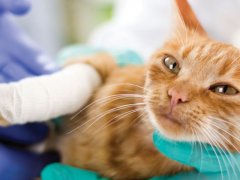
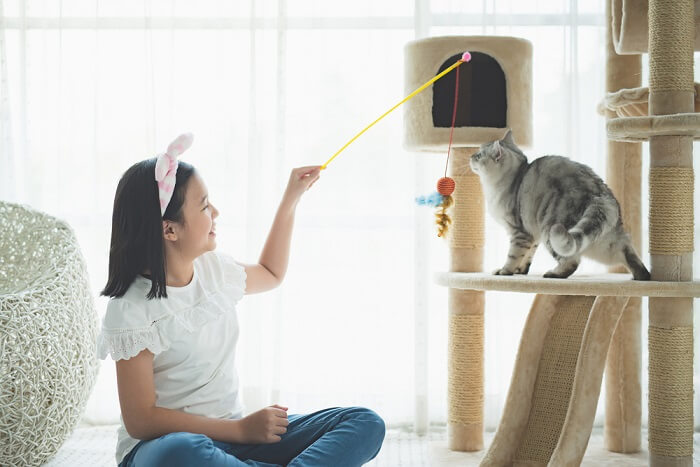
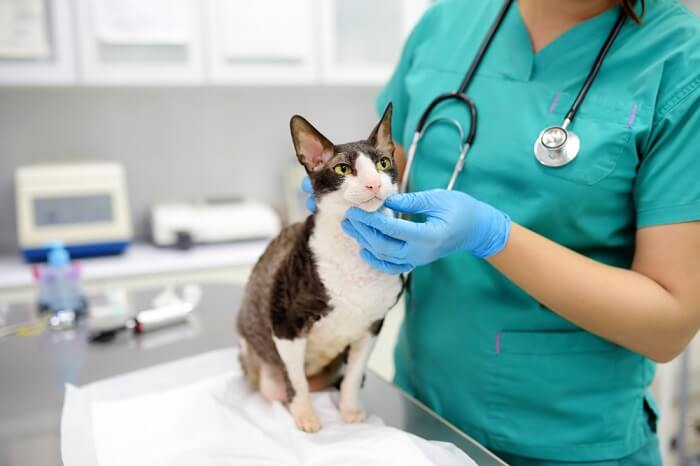
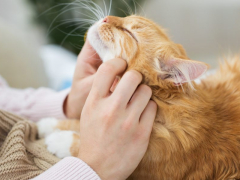
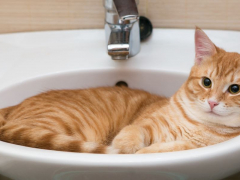
I felt a sense of relief by this comment from the article: “It is imperative to note that social relationships between cats can shift throughout life.” I had the most stressful experience with my 2 cats several years ago (the older one has since passed). After a solid 5 yrs of friendly co-existence, my younger cat suddenly started attacking my older cat. After ruling out health issues and many behavioral interventions over many months, they gradually arrived at a semi-peaceful detente. But they were never buddies again. During this difficult time, not even the cat behaviorist I consulted with mentioned that this kind of sudden change could occur. It was literally like a switch had been flipped in my younger cat. I would like to learn more about this phenomenon and why it happens. I will try googling, but if you could direct me to any resources I would appreciate it. Thank you.
Hi Michelle
Thank you for reading our article. I am sorry to hear your older one passed away.
You are correct; this is a powerful statement. Life is constantly flowing, including the relationships between cats.
I have witnessed dynamics shift during social maturity. Conflict can also occur due to health issues, the addition of a new pet and environmental factors.
Be aware that stress can also change the relationships between cats, especially those with sensitive temperaments.
I think finding scientific evidence might be challenging; however, I will see if I can find a few resources and be sure to email you directly.
All the best
Melina
I have two female Siamese cats. Same parents but 3 years apart. I have had them together for 3 years. The older cat tolerates the younger but often hissing or growling at her. They play at times and the older cat gets overstimulated and begins to get aggressive sometimes even hurting the younger one. They have separate everything and cat trees in every room also Fellaway in every room. I’m at my wits end with the growling and hissing. Do you think this is just the way it is or is there anything else I haven’t tried that might help?
Hi Deborah
I’m sorry to hear that your older cat is less tolerant of the younger one.
Increasing interactive play and predatory activities would be a good idea to keep your younger cat occupied. This will help reduce her need to seek attention from the older cat. The goal is not to stop their playtime together but to encourage more independent play with toys that mimic natural hunting behaviors instead of relying on the older cat.
It’s also possible that your older cat is more sensitive. Enrich the environment by providing both cats with olfactory stimulation, feeding enrichment, offering harness and leash walking opportunities, and ensuring your older one has plenty of places to retreat when she wants to be left alone.
Finally, consider using clicker training to keep your younger cat mentally engaged.
I hope this advice is helpful!
Melina
I love cats I have 10 of my own! now I know if there fighting or playing, Thank you so much.
Most welcome!
Melina
It’s me again! Thank you for your previous advice. My cats have started getting along so much better but we have run into a problem. My older cat has a routine when eating her wet food. We put it out for her in the morning, she eats half then leaves the rest to eat throughout the day. My new kitten however eats his wet food in two seconds and then runs right over to her wet food and finishes her dish. So not only is he now eating too much, she is not getting all of her food anymore. Any advice is greatly appreciated!
Hi Toni
It’s lovely to hear from you, and I’m glad the cats are getting along much better now.
Here are a few strategies you can try:
1. Use a microchip pet feeder.
2. Place the food on an elevated surface, like a cat tree, but remove it after your older cat finishes half the portion.
3. Feed the kitties in separate rooms with the doors closed.
4. Consider repurposing a wooden box and installing a cat flap that only allows your older cat to access her food.
Get creative, and good luck!
Melina
Hello! I have a 5 year old female cat and last week rescued a 5 month old male kitten. They have begun to really wrestle each other which results in my older cat getting overstimulated. I’m not sure if she is fighting or playing. She does not seem to be getting too aggressive but I have noticed that her teeth are out. And I think she gets overstimulated because the kitten is play biting. He also will not leave her alone. Anytime she goes to eat or if she’s cleaning herself, the kitten will run and sometimes jump on her back to play. Is this normal behavior and will it get better or progress to get worse? It usually ends with her biting his face and running away but then he chases after her. Thank you
Hi Toni
Congratulations on your recent adoption!
It’s entirely normal for your kitten to behave this way. His instinct to chase your female cat is part of his natural playfulness and high energy. Kittens are often inquisitive and exuberant, sometimes leading to frustration for adult cats, especially if they need some downtime to eat, groom, or rest in peace.
To help manage your kitten’s high energy and ensure a harmonious environment for both your cat, implement the following:
1. Set aside more dedicated play sessions with your kitten using toys like feather wands, balls, or mice.
2. Invest in puzzle feeders or toys that stimulate your kitten mentally and physically, keeping him entertained and engaged when you can’t play with him directly.
3. Provide your female cat safe spaces to retreat if she feels overwhelmed. Cat trees, tunnels or elevated areas can allow her to observe from above.
4. Monitor their interactions and be ready to intervene if your female cat seems stressed.
5. Separate them when unsupervised sometimes to avoid possible stressful encounters.
6. Place food in different areas of the home to reduce feeding competition.
7. Train your kitten to walk on a harness and leash. This will give him a more extensive ecosystem to explore, expand his energy and minimize pouncing on your female.
Best of luck, and enjoy the joys of cat parenthood!
Melina
Hi, in August we brought a new cat home and slowly introduced him (1yr male) to our resident cat (3yr female). At first it went pretty well but somehow it went off the rails and now things are awful. We started with them in separate rooms and introduced really slowly, like you are supposed to. For the first month there were lots of good signs – touching noses, sitting in same room ignoring each other, smelling butts, eating food or treats in proximity. But I don’t think we ever progressed to letting them be in the same room together for too long b/c every time we did, the new cat would always go after the resident cat and she’d hiss and growl and sometimes cry out. She was never actually hurt and we think the new cat didn’t intend to hurt her – he wanted to play, but she didn’t want to play that way. She wasn’t raised with other cats – she was in a shelter and we brought her home at age 2mos. He will always somehow jump on her and they end up rolling together and she doesn’t like that. He is super high energy – can play 10 times a day – she only needs to play 1-2x per day. And our resident cat doesn’t know how to run away from him – she can jump onto a curio where he can’t follow, but she never does. Also, she would go after him herself, which we thought was a good sign. Even when we tried to keep them separate, she would run out of the room to confront him. Every time they would get into it, we would run after them and split them up. Maybe that was a mistake and maybe we projected our stress onto them. After about 10 weeks of this, we got tired and just kept them in separate rooms. Now we are ready to try again, but somehow, in the past 2-3 weeks, our resident cat has become a hissing maniac. She hisses every time she sees or hears him, even under the door. She’ll still run out to confront him but now when he goes after her, it seems like their interactions are a bit worse. Maybe not. She’s also had diarrhea for about 6 weeks which we are in consult with the vet about. The vet seems to think it’s not caused by stress because she says the cat would be acting stressed. We have a small house and not much space to add more stuff. We currently have 2 litter boxes, two scratching posts, 2 floor scratchers, one cat tree that neither is using much, one hammock and they each have their own food/water bowls. We do not really have a place either can hide from the other. We have a baby gate installed and for a long time only resident cat could jump over it but now they both can. As I said above, our resident cat can jump onto our curio and new cat can’t yet? Can we teach her to jump there to get away from him? She seems to get super stressed when they are play/fighting and doesn’t know what to do.
Dear Supriya
Thank you for reaching out for support and advice.
Things initially started well, but the introduction process may have been unintentionally rushed. The two cats are in different age groups, have varying energy levels, and possess distinct personalities. Your resident female cat may feel negative emotions regarding the current situation.
Let’s begin the introduction process again, but we will take it much slower this time. Based on your comments, it may take between 4 and 6 months (approximately 1 month for each step, with around 5 steps total) for both cats to accept each other and live harmoniously.
Here are some recommendations to facilitate the re-introduction and to create a more suitable environment for both cats:
1. During the re-introduction, use a glass door or a SHRRL Reinforced Cat Screen mesh to separate new cats. This divides the two sides so the cats can see each other without physical contact. Toys, brushes, and safe places should be available on both sides.
2. Monitor each cat’s body language – to know when to proceed to the next step and when to take a step back if needed. Don’t rush the steps!
3. If relaxed post-scent transfer, encourage play on either side of the closed dividing glass or mesh door. Create a dumbbell-style toy by tying two toys with heavy string and placing one on each side of the closed door to separate the cats.
4. Don’t encourage or inadvertently reinforce assertive behavior – only focus on your resident cat when relaxed, not hissing, swatting at another cat or human or displaying aggressive behaviors. Move away, and don’t give your resident cat attention if she is hissing, growling and looking at you.
5. Do not allow overt, persistent threatening behaviors (e.g. hissing/growling at the glass or mesh door). If this occurs, do not discipline the cat for showing agonistic behaviors. Instead, create a neutral zone; this might involve closing another door or placing a visual barrier between the cats to block the barrier door (e.g., a shoji screen, boxes, or chairs).
6. Monitor the body language of both cats. Be ready to interrupt any escalation in reactivity. Have passive intervention readily available should tensions arise (e.g., ample towels, a blanket to cover the cats, or cardboard or laminate sheets to block visual contact).
7. During introductions, never interact with cats who are hissing, growling, tail flicking, urine marking, or showing other signs of arousal because cats who cannot access the cat they are directing their agonism toward may readily redirect frustration onto the closest target their guardian.
8. Consider placing a cat-safe collar with a well-secured tiny bell on the male. The bell’s gentle chime can serve as an early warning, allowing the resident cat to leave and avoid unwanted interaction, providing everyone with peace of mind.
9. Prevent cats from staring at each other by using a solid piece of furniture as a visual barrier or using vertical space. If this agonistic behavior is noticed between two cats, it is essential not to attempt to pick up the cats. Instead, defuse the tense situation by placing an inanimate object (e.g., pillow, cushion, cardboard or solid laminate sheet) between them to diminish eye contact and distract them; then redirect each of them independently onto another activity.
10. Provide sufficient escape routes during the introduction. All cats must have individual hiding spots, even in small homes (e.g., a spot inside the wardrobe, cat tunnels, cat condos, etc.).
11. Play calming classical music during the re-introduction and post-introductions.
12. Increase foraging opportunities and introduce puzzle feeding for the male cat. Start with a simple homemade puzzle feeder.
13. Clicker train the male cat to keep him mentally and physically simulated may also be helpful.
14. When conflict arises, remain calm and reduce the need for yelling or reprimanding, as these can exacerbate anxiety.
Feel free to contact me directly if you still have issues with the re-introduction process.
All the best
Melina
Hi I have an almost 2 year old cat and just recently rescued a 5 yr old cat. I’ve had the 2 year old since he was a kitten and knew he needed a friend after my roommate and her two cats moved out. I got the 5 yr old because his temperament seemed to match my cat. So far they have been completely fine with each others scents from the get go. (Have been doing scent and location swapping). We just moved to seeing each other through a screen door and for the most part it seems to be going good. My 2 yr old is completely unbothered and just wants to play.
However, the 5 yr old I can’t get a good read on. He did hiss and growl when seeing the other one for the first time but has since stopped doing that. He kinda just meows a bit at my cat and pounces (I think playfully through the screen door) but I just can’t tell. Body language is a bit off but not enough for me to be worried I think? I’ve done so much research but still am so unsure about finally letting them physically be around each other. Any advice is appreciated!
Hi Hannah
Great job successfully bringing home a five-year-old cat who seems to have a similar temperament to yours!
It sounds like introductions are progressing well, and any issues that may arise are likely related to predatory behavior. However, if you notice any negative responses (e.g. hiss, growl, flattened or rotated ears, tense body posture, etc.), it’s best to take things slower and delay moving on to the next step for a few days or even a week. I think it’s always better to proceed with caution and, if necessary, go back to the previous stage if things don’t go as planned.
I hope the cats enjoy each other’s company for many happy years!
All the best,
Melina
I have two cats I got about 2.5 months ago. Both 2 years old and not bonded. For awhile they were fine. Slight interactions of sniffing each other. The female would just likely swat if the male got too close. As the male got more accustomed to house and getting dental disease fixed he really opened up. He was more cuddly and super playful. He’d occasionally lay fairly close to the female when she was with me. Well one day he appeared to be trying to play with her, but she didn’t like it. She just screams and curls up, no fighting back. He also doesn’t try to lay near her anymore, doesn’t cuddle us as much (still very friendly to us tho), wants to play all the time (we do give him atleast 2 play sessions) and now we recently heard her scream nearly a minute to come find him on top swatting her (not super aggressive tho).
We really aren’t sure what to do or if he’s just trying to play. He’s never aggressive with her in any other way. Even if she swats him away from her food he just steps away with no aggression.
We aren’t sure what toys would be best to occupy him either. We have a cat tree, ball ring, wand, and small plastic balls he loves, but constantly gets stuck under things. I’m constantly concerned for my female cats stress. My wife just told me she’s even sleeping on my pillow every night since I left.
Hi Tony,
Congratulations on the recent adoption.
Female cats usually socially mature around 2 years old, while males mature between 3 and 4. Male cats are generally much more playful than females.
To prevent conflicts, feed them separately and introduce puzzle feeders to both cats in different house parts.
You can also plug in a Feliway diffuser or spray Feliway where the female cat rests to minimize stress. Please ensure both cats have enough resources to reduce competition (i.e. provide 2 cat trees, 2 scratchers, 3 litter trays, and 2 water bowls).
You can purchase a Go Cat Da Bird Cat Teaser to keep your cat stimulated. Additionally, ask your wife to place more t-shirts with your scent around the house while you’re away. This will help your cat feel more comfortable and less stressed in your absence. Here’s a helpful article about How to play with a Cat: https://cats.com/how-to-play-with-a-cat.
Overall, preventing inter-cat conflict requires environmental adjustments that promote cat distribution, decrease resource competition, reduce distress and irritability, and increase a cat’s self-confidence.
I hope this helps.
Melina
I have an almost 14 YO MN mediumhair cat that grew up with other cats and lived with them fairly harmoniously for years and when I moved out he only lived with my dog for a few years and has since become a bit more unhappy with other cats in general. I’ve been reintroducing for a year now one of the cats he used to live with years ago (7 YO MN shorthair) who is on steroids for his GI disease. It wasn’t the best relationship the first 4-6 months even with feliway plug ins in the house and both cats on anxiety meds but it has been much better between them for months now. I’ve been able to stop the anxiety meds for months and now I wanted to try to stop the feliway due to cost and how well they’ve been doing overall. I do notice that they will each interact playfully around toys and the scratching posts and poke at each other but the younger one sometimes wants to wrestle and that seems to bother the older one usually causing the older one to complain loudly, hiss, get up and only slightly pin back his ears with some light tail swishing. The younger one seems to realize that the older one has 10 pounds extra compared to him and calms a bit but I’m not sure that would always stop him (the steroids have made him more brave lol). I saw this tonight and was able to enter the room and grab some toys and both were very pleased with that change in play and there was no lingering issues after but I’m not sure if I just need to play with the younger one more often to get his energy out or if I should continue the feliway plug ins forever or? Any ideas would be appreciated. I have plenty of toy options and the house has lots of scratching posts, beds, food/water bowls, and window perches.
Hi Kim,
Sorry for not getting back to you sooner; I’ve been away pet-sitting.
I would continue playing more with the younger one and introduce clicker training to keep the young one engaged in mental and physical stimulation, which should reduce the need to pounce on the older one.
There is no need to keep the Feliway plug-ins forever.
I hope this helps.
Melina
I’m so sorry about that
I have two male cats, one is one year and a month we have had him since 5 weeks, he was socialized with an older cat, however we recently moved and it had been just him and us for a month. I just got a kitten a few days ago, he is 6 weeks, they are both black cats and my older cat was not a fan the first night. They have since gotten better, however the baby keeps attacking my older cats tail whenever it starts flicking. They have been chasing each other around the house but it is both ways. I do believe my older cat is more so confused and scared than angry but always is trilling when the baby pounces on his tail or he is chasing the baby around. I’m worried that I’m causing too much stress.
Hi Tori,
Congratulations on the relocation and new family addition.
Please be mindful of your emotions during the introduction phase to avoid projecting your worries onto your kitties.
Give your adult cat time to adjust to the new environment and kitten.
My 8-month-old kitten Sienna also likes to attack the adult cat’s tails. I usually carry jiggly toys or mice in my pocket to distract any undesirable behavior. When you’re around, before the tail chasing starts, toss a toy or a treat to redirect your kitten away from your adult cat. When left alone, keep both cats occupied with toys and puzzle feeders.
Most importantly, a gradual kitten-cat introduction will ensure harmonious living for many years to come.
Enjoy!
Melina
Hi Melina,
Such a helpful article, thank you! I recently adopted a 6mos. old neutered male kitten and slowly introduced him to my older 2yr old spayed female cat. Although the older cat seems threatened or dare I say jealous of the younger one, they’re able to tolerate each other and sometimes seem to play fight, the younger one wants to play and the older wants to fight lol. If I feel like they’re becoming too aggressive I distract the younger one with a chaser toy. There’s lots of resources for water, food, litter boxes, toys, tunnels, etc, And the older one is harness/leash trained so she gets supervised outside time. My question is what happens when I’m not home? Sometimes I’m away for 10hrs while at work. How can I ensure the playing doesn’t turn into a real fight or keep it from getting out of hand while I’m away for too long?
Thank you!
Dear Rana,
Thank you for reading our article, and congratulations on your new addition.
We also recently adopted a kitten who’s 7 months old and were worried about leaving all three cats alone for lengthy periods.
Initially, I used to leave the cats unsupervised for a short time only. I gradually increased the time from an hour to two to three.
Both cats must have interactive playtime with you twice daily and affection (if they enjoy it) to minimize boredom, reduce frustration and start fights.
Plug in a Feliway Diffuser and start Harness & leash walking the male kitten to reduce pouncing on the female.
Leave the cats plenty of things to do to stimulate their mind while you’re out of the house. Invest in various DIY and commercial puzzle feeders, plus leave them boxes for play and hiding opportunities.
A webcam is the ideal viewing platform to observe both cats and keep your mind at peace.
I hope this helps!
Melina
Hi and thank you for the article! I have an 11 year old and a 5 year old. The older lost his brother a year ago and very soon after we adopted the older cats. The remaining older cat hates the young one and chases him. The younger now fights back, but clearly also hates the older cat (glares) and constantly loses. I think they fight over me and territory. Any tips for the jealousy? They tolerate each other to some extent but the blocking and fighting is too much. The younger sleeps in our room and the older owns the couch. He used to not jump but now will get to anywhere the younger cat goes. I think the younger one wants to play and chirps at the older, but the latter will just chase, meow angrily, and scratch.
Hi Cathy,
Thank you for reading our article.
I have a similar situation at home. My 9-year-old male cat dislikes the five-month-old kitten I adopted recently. He is very jealous and fights over me and the territory.
Here are some ways to support both cats: 1. Offer sufficient resources spread around the house. 2. Introduce scent enrichment like Silvervine sticks or purchase a Cat Herb blend from Jackson Galaxy to improve well-being. 3. Set aside time daily for each kitty for play, grooming and walks. 4. Provide puzzle feeders, activity centres and many enrichment opportunities to keep both occupied. 5. Allow time out at different parts of the house for the old cat to chill and relax without the younger one pouncing or chasing him.
I hope this helps!
Melina
Hi!
I have a 12 year old cat who is staying with my parents and they have a 7 year old. My cat is notoriously a weirdo- he was a runt and stray and has only ever interacted with Felix (7yr old). They seem to be having fun when they play- Felix likes to lay down and uses soft paws and soft bites on Magnus (12) but sometimes Magnus has ears back (not down to his head just angled back) and his back fur is puffed up. There’s not growling or anything so sometimes I wonder if maybe he just doesn’t quite know how to play and Felix is being understanding of that. What do you think? I have a video too but not sure how to post it!
Hi Ashley,
Thank you for reading our article and for your comment.
It sounds like rough normal cat play behavior. However, since you can’t share videos in the comments field, here are great play vs fight between cats videos to help you distinguish whether they are playing: https://www.fundamentallyfeline.com/ding-round-47/, https://www.fundamentallyfeline.com/tabby-tusslin-raw-and-uncut/, and https://www.fundamentallyfeline.com/example-normal-feline-play-behavior/
I hope this helps,
Melina
I have 2 kittens from different litters , 14 weeks and 9 weeks. the older cat is aggressive to the younger and during fights I gear the younger hiss, howel etc . I’m confused as the older aggressive cat also thrills constantly at the younger kitten.
today is their first introduction following a weeks separation before actually meeting
are the cats just finding play boundaries?
Hi Cherrie,
Congratulations on the new additions to your family.
Have you had a chance to carry out an introduction process between both kittens, as mentioned in this article https://perfectpets.com.au/best-pet-blog/post/how-to-introduce-a-new-kitten-to-a-resident-cat?
Both kittens are from different social groups, so they most likely don’t recognize each other scent, which could be why the older kitten is aggressive towards, the younger one at this early stage.
They may also have different play styles and are getting to know each other.
Vicky Halls has co-authored newly published research that investigates social interactions between cats. This study (https://www.nature.com/articles/s41598-022-26121-1?fbclid=IwAR1S6l3mV5F63pUyS6ZLWjTqkiS2Q4BQgVaVnZJqtiYcN08-5JlVLtMOdvsmay) will provide some insights into your kittens’ behavior. Her findings concluded that ‘reciprocal wrestling was most closely associated with a group of playfully interacting cats, while vocalization and chasing were associated with the agonistic [fighting] group.
I hope this helps.
Melina
Hi Melina – thanks for this great article. We have two 3 year old brothers that were bonded as kittens. They were rescued as strays as very young kittens, and we’ve had them since they were 1.5 (as indoor only cats). As kittens they were close and regularly slept cuddled up, and although they no longer do this, there are lots of signs they still get along – they usually spend most of the day together, sleep in the same general areas, nose boop and sniff each other whenever they pass, groom each other. But they also fight often, almost always with one hissing or growling, and usually a trail of fluff left behind. It seems to start as play fighting – one stalking or pouncing the other, but always descends into vocalisation. There doesn’t seem to be an obvious trigger – they don’t seem fight over food or resources (they eat side by side happily). We have 3 litter trays and lots of beds and hiding spots. We play with them regularly. It almost seems as though they are trying to play fight but don’t know how to do it nicely or keep it under control. One has had urinary issues that may be caused by stress, and he seems to be the more common instigator. We haven’t been able to identify a cause for his stress.
Thank you for your feedback, Rachel.
Agree. It may start as a play fight and escalate further. My two siblings aren’t bonded either now that they have socially matured and get into fights when the male cat is bored and doesn’t get sufficient attention or playtime.
Trial increasing interactive playtime with the instigator, introduce clicker or harness & leash training and place an indoor webcam to pinpoint a potential trigger.
I hope this helps.
Melina
Hi, I have 2 kittens (3 months and 2 months) and we’ve had the older one for a month and a half while we’ve only had the younger for 2 weeks. When they play/fight it seems to me that the older one thinks it’s playing but the younger one I’m not sure if she thinks they’re playing or fighting, the older one’s tail is always relaxed but the younger one’s is sometimes raised. We have a Feliway diffuser in the younger one’s room and usually introduce the older one into that room but the younger one is skittish and whenever the older one stops fighting to play with a toy, the younger one starts a fight by trying to jump onto the older one. Neither of them have their claws out from what I can tell, and hey both spend time on the bottom but the older one is bigger so she tends to be on top of the other one more, and the younger one never chases the older one, it’s always the older one chasing the younger one. Is there anything I can do to figure out whether they’re both actually fighting, and to get them to get along? It’s been causing me some distress as we originally got the younger one to keep the older one company so that they don’t get sad when I’m at school, and I want them to get along so that I can be sitting at my lectures not worried about them hurting each other. Thank you!
Hi Tina
Congratulations on both kittens, such an incredible fun time.
It’s likely both cats have different energy drives and perhaps mismatched play styles.
Don’t stress, keep the Feliway plugged in and increase interactive play with the older one to 3 times per day with a feather wand type toy, perhaps the younger one prefers solitary play instead of social play. Get to know each individual kitten’s play likes and dislikes.
Here’s a link to How To Safely Play With A Cat; https://cats.com/how-to-play-with-a-cat, moreover here are great play vs fight between cats videos to help you decipher if they’re actually getting along: https://www.fundamentallyfeline.com/ding-round-47/, https://www.fundamentallyfeline.com/tabby-tusslin-raw-and-uncut/, https://www.fundamentallyfeline.com/ding-round-47/ and https://www.fundamentallyfeline.com/example-normal-feline-play-behavior/
Hope this helps and you will feel at ease soon
Regards
Melina
This really helped thank you! I watched the videos (they’re very helpful by the way, thank you for linking them) and I think they are just playing, but sometimes while wrestling the younger one will make some meow-like noises. Should i break them up whenever that happens?
Glad I could help Tina. If you feel the younger one isn’t enjoying it any longer or it’s too rough, feel free to break it up by either throwing a towel, clapping your hands or redirect the older one to a toy.
Enjoy kittenhood, it’s the best time.
Melina
Thanks so much for this information! We recently introduced our 7 year old cat to an adopted 4 year old cat. Both have been socialized with other cats. My 7 year old cat has groomed our new cat, but this seems to result in a fight afterwards. My 4 year old cat makes noises and flicks his tail which tells me he is bothered by the grooming, which then starts the fight. The fight is easy to break up and the cats are typically sleeping or doing other activities soon thereafter in the same area. This is the same for times when they fight which is not initiated by grooming. Is the grooming before the fighting a sign that this may be play? Should we allow the fights to happen or break it up?
Hey Luke, it’s hard to tell what cats are thinking and, as you’ve noticed, their moods can change quickly. The tail flicking and noises can certainly be signs of fighting. You probably won’t be able to break up every fight, but it might not be a bad idea if things get intense.
Something you could try is using a little positive reinforcement to encourage non-aggressive interaction. For example, when the old cat is grooming the new cat, give them both a few treats. If they’re relaxing next to each other, another treat. You can also try playing with both of them at the same time and again, give some treats. Things like this will help them form a positive association with time spent with each other.
Good luck!
Hi, thanks for the info! My kittens have play fought since the day I got them, however they do often exhibit some actual ‘fighting’ signs like the ears being backwards and one of them often does the sideways walk while playing. Over the past couple of days since I’ve been back home after a couple of weeks away (housemate looked after cats so they didn’t have to leave their usual environment) one of the cats (both males) has taken to making the little trilling noise when he bites my other cat, and seems intent on not giving up. It still doesn’t seem serious but I’m worried as it’s a change I haven’t seen before that there has been a change in their dynamic!
Fascinating question, Ashleigh! If the cat isn’t showing any other indicators of aggression or hostility, I wouldn’t view this behavior as a cause for concern.
How do you handle when one cat is treating it as play and the other is treating it like a fight?
I have two cats. I have had my 5 year old female for 4 years, and my almost 2 year old female that I’ve had for 3 months, both are former strays. My younger cat is having fun and treats everything as a game, but my older cat (while she’s getting better) will sometimes get very stressed out by the whole thing and reacts to play bites, batting, and tackles with pinned ears, growling, hissing etc.
I have lots of hides and multiple cat trees/high places for the cats to hang out, but I just don’t really know what to do when an incident occurs. I usually can break it up pretty easily. The younger can just sort of be picked up and moved. But is this the right way to handle it?
My older cat is the more well socialized of the two. She lived with a colony of ferals that was captured for TNR, but she was malnourished and deemed unable to care for herself and was friendly enough that they put her up for adoption. She lived with another cat before when I had a roommate and generally found him (the other cat) quite annoying, but she at least would initiate play with him. Something I have yet to see her do with my new-ish cat.
My younger cat lived in an Arby’s dumpster by herself for approximately a year until she became so heavily pregnant that it slowed her down enough to allow an Arby’s employee to catch her (according to her foster she was the best momma cat they’ve ever had). Younger cat is also some sort of Persian mix with a flat face that leads to her snorting like a pig after any sort of exertion (yes I’ve spoken to my vet about it) and the least athleticism of any cat I’ve ever met (she can’t reach any of the high places my older cat loves to hang out on like the bookshelf, and she’s even shaky reaching the top of the cat tree though she loves the ground hides I’ve got scattered through the apartment).
Hi Brianna,
Well done on the environmental set up, you can add more resources to minimize competition with tunnels and boxes.
If you need to break up a fight, throw a towel or small blanket on both cats to break it up.
I would also increase play therapy with your almost 2 year old female and re-divert her attention with toys when your 5 year old female doesn’t wish to interact.
When inter-cat conflict occurs, re-introductions through positive reinforcement are recommended. You can read more about how to help cats get along here https://cats.com/how-to-help-cats-get-along
Hope this helps
I think intervening is the appropriate thing to do. it sounds like the older cat might feel like she’s being attacked by the younger one, causing her to react by attacking instead of playing. it’s probably stressful for her, feeling like she’s being ‘hunted’ by the other.
I enjoyed reading your comment Brianna and just wanted to say a few things to you….First of all you are doing things right and your concern for your kitties is heart warming. The hideouts you supply them is perfect. Cats love to hide and love their privacy. Just about everything is on their terms though. We just have to respect that in them. Cats for the most part don’t like to be held. I think it has something to do with their ability to protect themselves and feeling confined. Some will however tolerate it. LOL Katie my 2 year old will show a little aggressiveness sometimes with me if I pet her when she doesn’t want to be petted or held. I’ve accepted the fact it was what Momma cat taught her. Some cats will tolerate being held though.
Yes I also have 2 cats. Both are rescues and are female. My older cat Katie is 2 years now and very subdue. She is a tuxedo, black and white and seems happy. She’s not the outgoing personality as Sadie, they are all different. I got my second girl, a Tabby, Sadie at 6 weeks, (now 1 year old) found under a wood pile, sick with eyes stuck shut and full of fleas. She went right to the vet who cleared everything up. He said any longer on her own she would have died. She is now 1 year old and the most delightful kitty with personality plus. I kept them apart for one week when I first got her and in separate rooms. I didn’t know how Katie would accept her. This was also to allow her to get use to the new kitty scent and accept the new kitty as a permanent resident. This worked perfectly. After one week my then 1 year old Katie was begging to get into the new kitty room. I finally opened the door a bit and she forced herself in. The younger one as a 6 week old kitten at the time ran to her and wanted to play. At first I was terrified to what might happen. But It was an immediate acceptance by both. They love each other, play, eat, sleep together and groom each other. There has never been an aggressive incident with either one and I’ve had my newest, Sadie, for over a year now. Full of mischief yes. Chasing each other can be a problem as they knock things over, like a crystal lamp. and pictures. Many things broken. I have a spray bottle with water in it and when they see it they run. LOL It works very well! No one gets hurt, they just hate getting wet. LOL If there is ever any aggressiveness between them I’m sure the water spray will suffice. They are indoor kitties with cat trees to climb, open screened windows to sit in. They enjoy a large house and do not feel cramped or caged. I want these two to be happy here especially since they both had a not so nice start in life. I think lots of love goes a long ways. Sadie is funny, when she gets scolded for something, she will then come over to me and rub herself against my leg as if to say don’t be mad at me. She does this every time. Of course I shower her with affection to let her know she is loved just not her behavior some times. Cats are delightful creatures. I might add I once had trouble with mice before I got either one of them, but you guessed it, no more mice. They packed up and moved on. LOL I wish you the very best Brianna with your kits. I’m sure they love you very much for all the good things you do for them.
Thanks for all this info, Melina! It’s been a lot of work with my recent adoption. I think he didn’t have much socialization as a kitten, so he didn’t understand how to play and recognize other cats boundaries. He’s becoming better at it though, so I’m proud of him 🙂